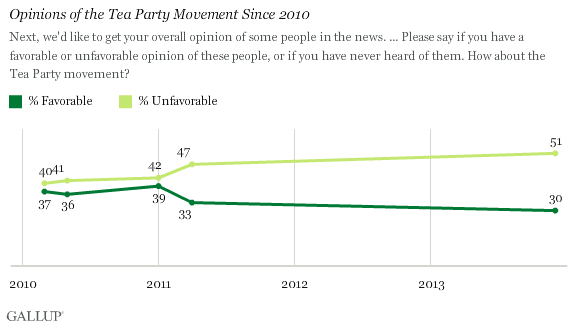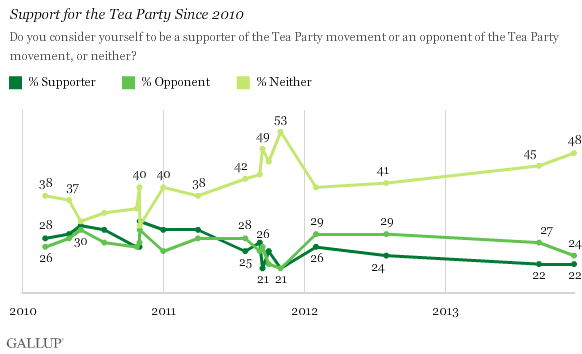PRINCETON, NJ -- For the first time, a slim majority of Americans say they have an unfavorable opinion of the Tea Party movement. About one-third view the movement favorably, a new low. A smaller percentage, 22%, in a separate question identify themselves as supporters of the movement, while 24% describe themselves as opponents. Nearly half (48%) are neutral.

The majority of Republicans, 58%, say they have a favorable opinion of the Tea Party movement, with slightly more than one-quarter (28%) viewing it unfavorably. Democrats, on the other hand, are largely unfavorable toward the group, with 74% reporting an unfavorable view. Independents fall in between the two parties, but are more likely to view the movement unfavorably than favorably.
Though the Tea Party espouses conservative fiscal goals, self-identified conservatives, as a whole, are somewhat divided about the movement. A full third (34%) of conservatives have an unfavorable opinion of the group, while 48% are favorable.
By contrast, liberals are largely critical of the Tea Party: 80% view it unfavorably. Moderates' views fall between those of liberals and conservatives, but still tilt negative.

Supporters and Opponents of the Tea Party Have Dwindled Since 2012
The proportion of Americans who consider themselves supporters of the Tea Party movement, 22%, is approximately equal to the proportion considering themselves opponents, 24%. Almost half do not consider themselves supporters or opponents, an increase of eight percentage points since February of last year, and among the highest readings Gallup has recorded on this issue.
The percentage calling themselves opponents reached 29% in February and August 2012, close to the all-time high of 30%. This percentage has fallen in 2013, with the largest drop between September and December.

Implications
The image of the U.S. Tea Party movement was fairly neutral in 2010, when its political activism may have helped Republicans retake majority control of the U.S. House. By 2011, however, more Americans viewed it unfavorably than favorably, and today they hold a more negative opinion than ever.
The Republican and Democratic parties have also been suffering from an increasingly negative public image, and as long as the Tea Party is viewed as contributing to the unpopular partisan conflict in Washington, rather than remedying it, the movement is likely to remain controversial.
Still, this movement does not seem focused on becoming a major third party in the U.S., but rather on pushing the Republican Party to the ideological right. Its popularity among Republicans may be most important, and on that score, the Tea Party is still doing fairly well.
Survey Methods
Results for this Gallup poll are based on telephone interviews conducted Dec. 5-8, 2013, on the Gallup Daily tracking survey, with a random sample of 1,031 adults, aged 18 and older, living in all 50 U.S. states and the District of Columbia.
For results based on the total sample of national adults, the margin of sampling error is ±4 percentage points at the 95% confidence level.
Interviews are conducted with respondents on landline telephones and cellular phones, with interviews conducted in Spanish for respondents who are primarily Spanish-speaking. Each sample of national adults includes a minimum quota of 50% cellphone respondents and 50% landline respondents, with additional minimum quotas by region. Landline and cell telephone numbers are selected using random-digit-dial methods. Landline respondents are chosen at random within each household on the basis of which member had the most recent birthday.
Samples are weighted to correct for unequal selection probability, nonresponse, and double coverage of landline and cell users in the two sampling frames. They are also weighted to match the national demographics of gender, age, race, Hispanic ethnicity, education, region, population density, and phone status (cellphone only/landline only/both, and cellphone mostly). Demographic weighting targets are based on the March 2012 Current Population Survey figures for the aged 18 and older U.S. population. Phone status targets are based on the July-December 2011 National Health Interview Survey. Population density targets are based on the 2010 census. All reported margins of sampling error include the computed design effects for weighting.
In addition to sampling error, question wording and practical difficulties in conducting surveys can introduce error or bias into the findings of public opinion polls.
View methodology, full question results, and trend data.
For more details on Gallup's polling methodology, visit www.gallup.com.
